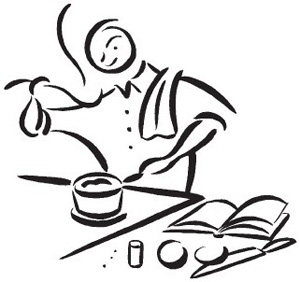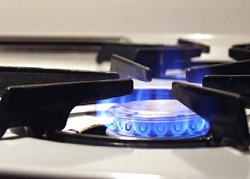 When my oldest son left for his senior year of college in September, he was leaving the comfort (or more likely uncomfort) of on-campus life and trading it for a 4-bedroom apartment. No
longer able to rely on cafeteria food, he was going to have to cook for
himself. Over the years I had taught him a few basic things about cooking but
never really gave him anything resembling real lessons. I guess I was just
hoping he was going to pick it up by osmosis. Though he has watched me cook
over the years and picked up some basics I wanted to give him a little more
formal culinary send-off. Starting in early August I began to think about what
he liked to eat and what specific skills he would need to cook those dishes. We
spent a few days going over the basics – heat control, knife techniques, etc. I
also knew that there were certain basic tools and ingredients he would need for
his kitchen. Stuffed into his luggage were three knives, a spatula, frying pan
and pot. Finally, I drew up a few basic recipes and cooking techniques that I
emailed to him. The result was a sort of mini- cooking ‘Cooking 101.
When my oldest son left for his senior year of college in September, he was leaving the comfort (or more likely uncomfort) of on-campus life and trading it for a 4-bedroom apartment. No
longer able to rely on cafeteria food, he was going to have to cook for
himself. Over the years I had taught him a few basic things about cooking but
never really gave him anything resembling real lessons. I guess I was just
hoping he was going to pick it up by osmosis. Though he has watched me cook
over the years and picked up some basics I wanted to give him a little more
formal culinary send-off. Starting in early August I began to think about what
he liked to eat and what specific skills he would need to cook those dishes. We
spent a few days going over the basics – heat control, knife techniques, etc. I
also knew that there were certain basic tools and ingredients he would need for
his kitchen. Stuffed into his luggage were three knives, a spatula, frying pan
and pot. Finally, I drew up a few basic recipes and cooking techniques that I
emailed to him. The result was a sort of mini- cooking ‘Cooking 101.
It simply is not enough to caution our kids about transfats, prepared foods or high-fructose corn syrup. If you think about it most of the nutrition information we try to impart to our children is simply a list of things to eat but no one ever tells them how to cook or prepare the food. And the result is that as much as a twenty-something may know about eating his veggies, if no one ever shows him (or her) how to make a tasty vegetable dish, then all the cautionary words are for naught. More importantly, if you don’t learn how to cook you are much more likely to eat microwaved prepared foods or go out for fast food. I know most of us learned to cook by trial and error, but why leave such an important part of our living to chance when we really don’t have to?
Basic Spices and Cooking Items You Should Have
 Kosher salt or if you can get it sea salt is better
Kosher salt or if you can get it sea salt is better
Black pepper
Garlic powder (not garlic salt)
Onion powder
Red chili flakes
Chili powder
Cumin powder
Soy sauce
Balsamic vinegar
Olive oil
Canola oil
Box of cornstarch
Maple syrup (the real stuff not corn syrup shit) or honey
Ketchup
Mustard
Mayo
Hot sauce of your choice
Polenta (instant kind)
Brown or white rice
1 box of flour
*Box of Arm & Hammer baking soda that you open up and put in back corner of refrigerator on first shelf – great for absorbing odors- change every month if possible – only costs less than a buck and when finished put down garbage disposal – cleans it well – also put used lemons down disposal as well.
Note About Heat Levels:
The recipes denote various heat levels on stove. the biggest challenge in cooking, though one that is never written about is getting the heat levels right so you get the right consistency of heat for the food you are cooking. of course you will have to experiment with your stove but most of your cooking will be done at medium levels.
If you have an electric stove there will of course be numbers on each burner, here is the key:
# 2-3 – low heat
#4 – low medium heat
#6 – medium heat
# 8 and above high

For a gas stove:
Low heat: when the flame flickers just above the burner itself
Low medium: when the flame is about 1/4 to 1/2 inch just under the cooking grate
Medium heat: when flame is at the grate or right under it
High is obvious – when flame is all the way up
Next Up: Basic Recipes Everyone Can Master
Paul Mones is nationally recognized children's rights attorney specializing in representing sexual abuse victims and teens who kill their parents. He is also a published author and most importantly an avid chef who won the 1978 North Carolina Pork Barbecue Championship.